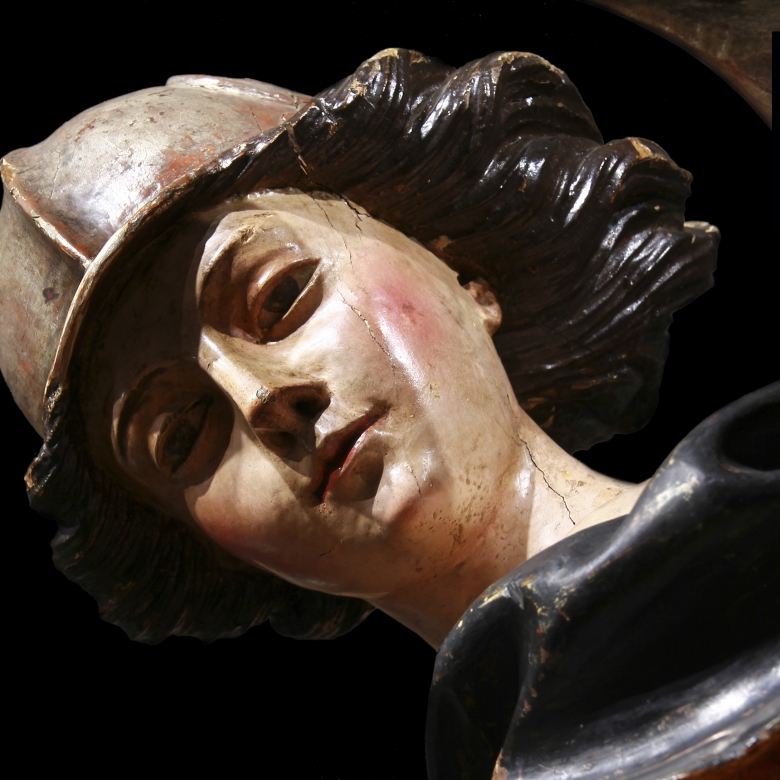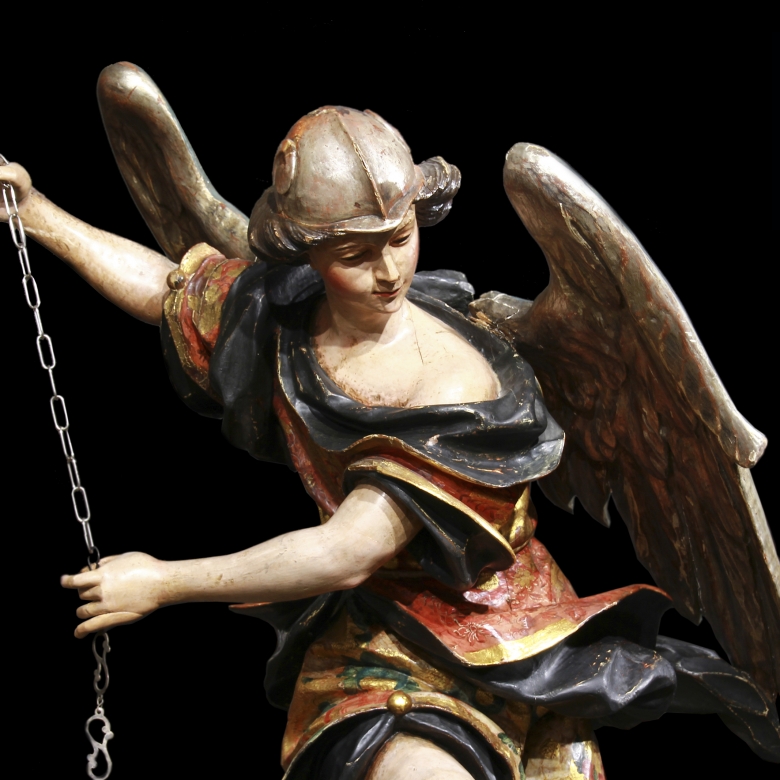10 MARCH 2021 - LIVE AUCTION
Pair of lamp angels, attributed to the circle of Pedro Roldán, late 17th century
Pair of lamp angels, attributed to the circle of Pedro Roldán, late 17th century
Carved, glued, stuccoed, bolted, polychrome and stewed wood.
127x70x83 cm (without base)
Pair of winged angels belonging to the Sevillian school until the end of the 17th century, used in some churches as a support for large lamps to illuminate a High Altar.
Angels are celestial beings, surrounded by light, who help to worship God and act as messengers between Heaven and Earth. Sometimes they dress in military clothing, as in this case, where they wear a rigid helmet typical of this type of clothing. The theme of angels is recurrent during the Baroque period although its origin took place in the Middle Ages. These sculptures were created to form a set with elaborate Baroque altarpieces and stand attached to thick walls.
Consequently, these sculptures simulate descending from the heavens with their gaze directed towards the faithful, who observe them from below. Because of this, both the mane and the cloths seem on movement. Within the Baroque period the sculpture stands out for its movement, following this trend, the position of the body seems to be curled on an axis, in this case formed by the shoulder and the foot. As they are arranged to mirror, one has the axis on the left and the other on the right.
Rarely found in art market history, this unusual pair of sculptures features stewed details and a polychrome design of large naturalistic flowers arranged in a staggered pattern in red and pink.
The great value of these sculptures is reflected in their extraordinary size, quality and fabulous state of conservation; in which we find the quasi perfect state of the original polychrome, except for small cracks originated over the centuries, the minimum repaints and slight restorations. All this, without forgetting its attribution to the circle of Pedro Roldán.
At the end of the seventeenth century and approximately from the 1720s throughout Europe, designs called bizarre, from the French term "bizarre", developed and began to be disseminated in Lyon. The design is combined with a golden background, preserved practically intact, made with the stew technique. They also retain the original incarnation, which can be seen both on the face and on the legs. In these parts we can only see several restorations in the little finger and one of the legs, the state of conservation they present is remarkable. The incarnations made in the Sevillian school are usually matt and create a great sense of realism.
Pedro Roldán's workshop, where numerous apprentices and sculptors were present, produced works for numerous altarpieces in various churches. Similar to these, the works carried out in the Conventual Church of Santo Ángel de la Guardia (Seville), in whose restoration Antonio Diaz Arnido participated, and the altarpiece and angels of the Church of San Jorge of the Hospital de la Santa Caridad (Seville) .
Antonio Díaz Arnido indicates:
Unfortunately neither of the couples has documentation since the Community archive was destroyed in the French invasion in the 19th century. However, the lampareros angels of Seville are historically and orally attributed to Roldán's workshop, at the end of the s. XVII.
“The resemblance is undeniable. I would even dare to say that the same artist made both pairs of angels. "
Detailed view of the polychrome of the Lampareros Angels, Conventual Church of the Holy Angel of the Guard.
Verificado por el Especialista - Verified by the Specialist.












